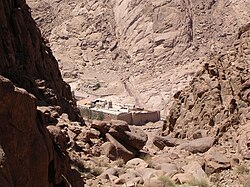Top Qs
Timeline
Chat
Perspective
Mount Sinai
Mountain in the Sinai Peninsula From Wikipedia, the free encyclopedia
Remove ads
Mount Sinai,[b] also known as Jabal Musa (Arabic: جَبَل مُوسَىٰ, lit. 'Mountain of Moses'), is a mountain on the Sinai Peninsula of Egypt. It is one of several locations claimed to be the biblical Mount Sinai, the place where, according to the sacred scriptures of the three major Abrahamic religions (Torah, Bible, and Quran), the Hebrew prophet Moses received the Ten Commandments from God.[1][2][3]
It is a 2,285-meter (7,497 ft), moderately high mountain near the city of Saint Catherine in the region known today as the Sinai Peninsula. It is surrounded on all sides by higher peaks in the mountain range of which it is a part. For example, it lies next to Mount Catherine which, at 2,629 m or 8,625 ft, is the highest peak in Egypt.[4]
Remove ads
Geology

Mount Sinai's rocks were formed during the late stage of the evolution of the Arabian-Nubian Shield. Mount Sinai displays a ring complex[5] that consists of alkaline granites intruded into diverse rock types, including volcanics. The granites range in composition from syenogranite to alkali feldspar granite. The volcanic rocks are alkaline to peralkaline, and they are represented by subaerial flows and eruptions and subvolcanic porphyry.
Remove ads
Religious significance
Judaism and Christianity
Immediately north of the mountain is the 6th-century Saint Catherine's Monastery. The summit has a mosque that is still used by Muslims, and a Greek Orthodox chapel, constructed in 1934 on the ruins of a 16th-century church, that is not open to the public. The chapel encloses the rock which is considered to be the source for the biblical Tablets of Stone.[6] At the summit also is "Moses' cave", where the Hebrew prophet Moses is believed to have waited to receive the Ten Commandments from God.[1][2][3]
Islam
The Jabal Musa is associated with the Islamic prophet Mūsā ibn ʿImrān (i.e., Moses).[2] In particular, numerous references to Jabal Musa exist in the Quran,[7][8] where it is called Ṭūr Saināʾ,[9] Ṭūr Sīnīn,[10] and aṭ-Ṭūr[11][12] and al-Jabal (both meaning "the Mount").[13] As for the adjacent Wād Ṭuwā (Valley of Tuwa), it is considered as being muqaddas[14][15] (sacred),[16][17] and a part of it is called Al-Buqʿah Al-Mubārakah ("The blessed Place").[12]
- Saint Catherine's Monastery, looking down from Mount Sinai
- The mosque at the summit
- The chapel at the summit
Remove ads
Ascent and summit
There are two principal routes to the summit. The longer and shallower route, Siket El Bashait, takes about 2.5 hours on foot, though camels can be used. The steeper, more direct route (Siket Sayidna Musa) is up the 3,750 "steps of penitence" in the ravine behind the monastery.[18]
- NNE view from the summit
- NW view from the summit
- The last few meters of the climb up the mountain
- Sunrise
See also
- Hashem El Tarif
- Sacred mountains
- Jebel Musa, Morocco, a similarly named mountain in Morocco
References
External links
Wikiwand - on
Seamless Wikipedia browsing. On steroids.
Remove ads










